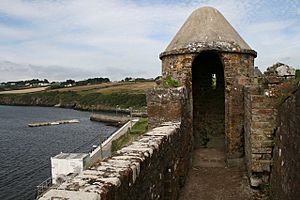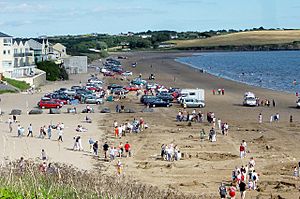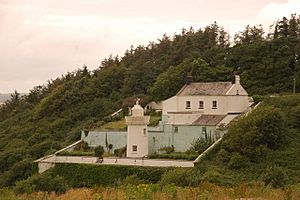Duncannon facts for kids
Quick facts for kids
Duncannon
Dún Canann
|
|
|---|---|
|
Village
|
|

Watchtower at Duncannon Fort
|
|
| Country | Ireland |
| Province | Leinster |
| County | County Wexford |
| Elevation | 48 m (157 ft) |
| Population
(2016)
|
|
| • Total | 305 |
| Time zone | UTC+0 (WET) |
| • Summer (DST) | UTC-1 (IST (WEST)) |
| Irish Grid Reference | S728082 |


Duncannon (Irish: Dún Canann) is a small village in southwest County Wexford, Ireland. It sits on a rocky piece of land that sticks out into Waterford Harbour. This location makes it very important for controlling the sea entrance to the harbor. The famous Duncannon Fort stands proudly over the village.
Duncannon is mainly a fishing village. But it also welcomes many visitors who come for its beauty and history. It is part of the "Ring of Hook" drive, a popular route for tourists. Duncannon beach is a mile long and was once recognized as a "Blue Flag" beach for its cleanliness.
Duncannon Fort was built in 1588. It was even used as a filming location for the movie 'The Count of Monte Cristo' in 2002. After being closed for a while, the fort reopened in 2016. Now, you can take guided tours to explore its history.
Contents
Exploring Duncannon's Past
According to old stories, Duncannon has been a settlement since the 3rd century AD. This was around the time of the legendary Irish hero Fionn mac Cumhaill (Finn McCool).
Why Duncannon Was Important
Duncannon was very important because its fort guarded the entrance to Waterford harbor. This meant it played a big role in many wars. During the 17th and 18th centuries, the village and fort were often involved in battles.
Duncannon During the Irish Confederate Wars
From 1641 to 1652, Ireland was in a period of conflict called the Irish Confederate Wars. The fort at Duncannon was first held by English soldiers. They used it as a base to attack nearby Redmond's Hall. During this time, the fort was attacked three times.
In 1645, an Irish army led by General Thomas Preston took control of the fort. The English soldiers inside gave up after a long attack. A ship trying to bring supplies to the fort was sunk, and many lives were lost.
Duncannon and Oliver Cromwell
Later, during the Cromwellian conquest of Ireland, Duncannon was attacked again. In 1649, Oliver Cromwell himself tried to take the fort. But the Irish soldiers bravely defended it, and Cromwell had to give up. However, in 1650, the fort and town finally surrendered after the city of Waterford fell.
Loyalty and Royal Visits
In 1659 and 1660, Duncannon was one of the few places that stayed loyal to Edmund Ludlow. This was when other towns were changing sides.
During the Williamite war in Ireland (1689–1691), King James II left Ireland from Duncannon. He sailed to France after losing the battle of the Boyne. Later, his enemy, William of Orange, marched through Duncannon. The town and fort surrendered to William's army without a fight.
The 1798 Rebellion
In the Irish Rebellion of 1798, Duncannon Fort was one of the few places in County Wexford that the rebels did not capture. It became a safe place for people loyal to the government. It was also used as a prison.
Later Importance
Even in the 19th century, Duncannon's importance was recognized. Napoleon, a famous French leader, even gathered information about the fort. He was thinking about a possible invasion of Ireland. In the 20th century, Fórsa Cosanta Áitiúil (the Irish army reserve) used Duncannon Fort as a training center.
Getting Around Duncannon
You can reach Duncannon by Bus Éireann route 370. This bus connects the village to New Ross, Waterford, and Wellingtonbridge. Buses run daily, except on Sundays. The closest train station is Waterford railway station, about 22 km away. You can get there by taking a ferry from Ballyhack to Passage East and then traveling to Waterford.
Sports in Duncannon
Duncannon has a local Gaelic Athletic Association (GAA) club called St James' G.A.A club. They play both Gaelic football and hurling. In 2015, the football team won the Wexford Senior Football Championship. The hurling team has also won several county titles. Some famous players from the village include Matthew O'Hanlon and Graeme Molloy.
The local soccer team is Duncannon United. They play in the Wexford League.
What to Do in Duncannon
Duncannon has several places to eat and relax. There are three pubs, two cafes, and a local shop. You can also find restaurants like Aldridge Lodge and Dunbrody Country House. The Duncannon Holiday Park offers places to stay, including camping.
Duncannon Fort is a great place to visit. It has a maritime museum, an art gallery, a cafe, and craft shops. It's open daily from June to September. During other times of the year, you can still take guided tours on weekdays.
Fun Events in Duncannon
Duncannon hosts several exciting festivals each year, especially in August.
- Sand Festival: This event takes place on the beach. You can see amazing sand sculptures in a large tent. There's also a crab fishing competition and a fireworks show!
- Kitesurfing Festival: Also in August, this festival celebrates kitesurfing. The exact date depends on the tides.


